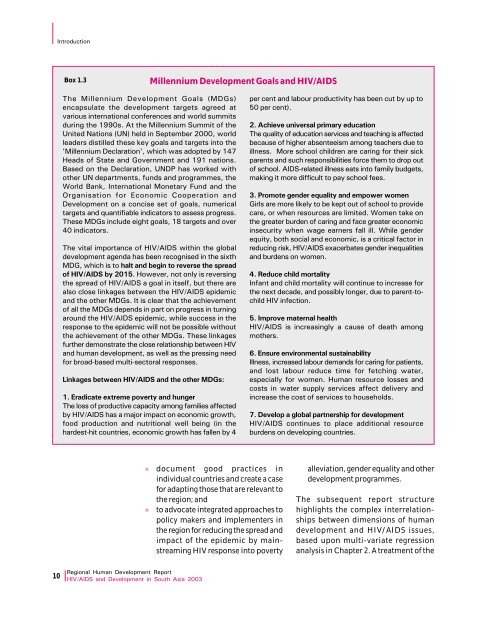Download Report - UNDP Asia-Pacific Regional Centre - United ...
Download Report - UNDP Asia-Pacific Regional Centre - United ...
Download Report - UNDP Asia-Pacific Regional Centre - United ...
You also want an ePaper? Increase the reach of your titles
YUMPU automatically turns print PDFs into web optimized ePapers that Google loves.
IntroductionBox 1.3Millennium Development Goals and HIV/AIDSThe Millennium Development Goals (MDGs)encapsulate the development targets agreed atvarious international conferences and world summitsduring the 1990s. At the Millennium Summit of the<strong>United</strong> Nations (UN) held in September 2000, worldleaders distilled these key goals and targets into the'Millennium Declaration', which was adopted by 147Heads of State and Government and 191 nations.Based on the Declaration, <strong>UNDP</strong> has worked withother UN departments, funds and programmes, theWorld Bank, International Monetary und and theOrganisation for Economic Cooperation andDevelopment on a concise set of goals, numericaltargets and quantifiable indicators to assess progress.These MDGs include eight goals, 18 targets and over40 indicators.The vital importance of HIV/AIDS within the globaldevelopment agenda has been recognised in the sixthMDG, which is to halt and begin to reverse the spreadof HIV/AIDS by 2015. However, not only is reversingthe spread of HIV/AIDS a goal in itself, but there arealso close linkages between the HIV/AIDS epidemicand the other MDGs. It is clear that the achievementof all the MDGs depends in part on progress in turningaround the HIV/AIDS epidemic, while success in theresponse to the epidemic will not be possible withoutthe achievement of the other MDGs. These linkagesfurther demonstrate the close relationship between HIVand human development, as well as the pressing needfor broad-based multi-sectoral responses.Linkages between HIV/AIDS and the other MDGs:1. Eradicate extreme poverty and hungerThe loss of productive capacity among families affectedby HIV/AIDS has a major impact on economic growth,food production and nutritional well being (in thehardest-hit countries, economic growth has fallen by 4per cent and labour productivity has been cut by up to50 per cent).2. Achieve universal primary educationThe quality of education services and teaching is affectedbecause of higher absenteeism among teachers due toillness. More school children are caring for their sickparents and such responsibilities force them to drop outof school. AIDS-related illness eats into family budgets,making it more difficult to pay school fees.3. Promote gender equality and empower womenGirls are more likely to be kept out of school to providecare, or when resources are limited. Women take onthe greater burden of caring and face greater economicinsecurity when wage earners fall ill. While genderequity, both social and economic, is a critical factor inreducing risk, HIV/AIDS exacerbates gender inequalitiesand burdens on women.4. Reduce child mortalityInfant and child mortality will continue to increase forthe next decade, and possibly longer, due to parent-tochildHIV infection.5. Improve maternal healthHIV/AIDS is increasingly a cause of death amongmothers.6. Ensure environmental sustainabilityIllness, increased labour demands for caring for patients,and lost labour reduce time for fetching water,especially for women. Human resource losses andcosts in water supply services affect delivery andincrease the cost of services to households.7. Develop a global partnership for developmentHIV/AIDS continues to place additional resourceburdens on developing countries.l document good practices inindividual countries and create a casefor adapting those that are relevant tothe region; andl to advocate integrated approaches topolicy makers and implementers inthe region for reducing the spread andimpact of the epidemic by mainstreamingHIV response into povertyalleviation, gender equality and otherdevelopment programmes.The subsequent report structurehighlights the complex interrelationshipsbetween dimensions of humandevelopment and HIV/AIDS issues,based upon multi-variate regressionanalysis in Chapter 2. A treatment of the10<strong>Regional</strong> Human Development <strong>Report</strong>HIV/AIDS and Development in South <strong>Asia</strong> 2003
















